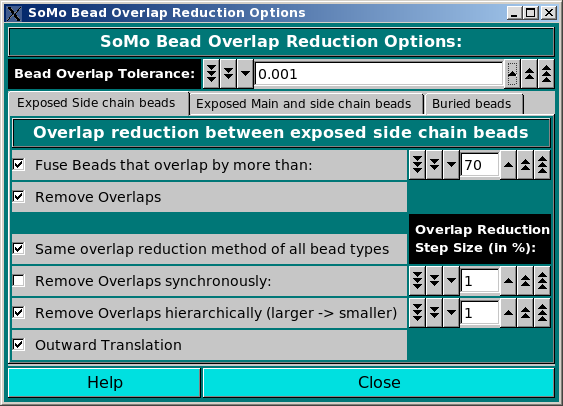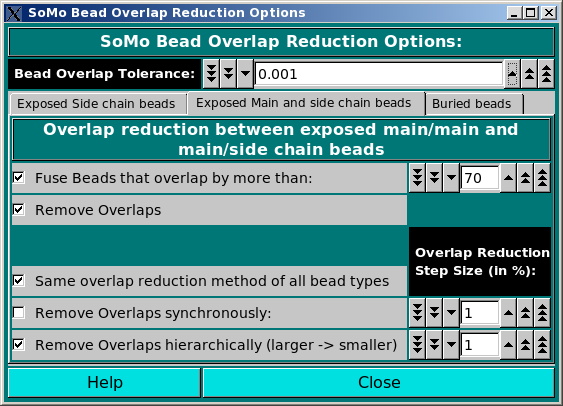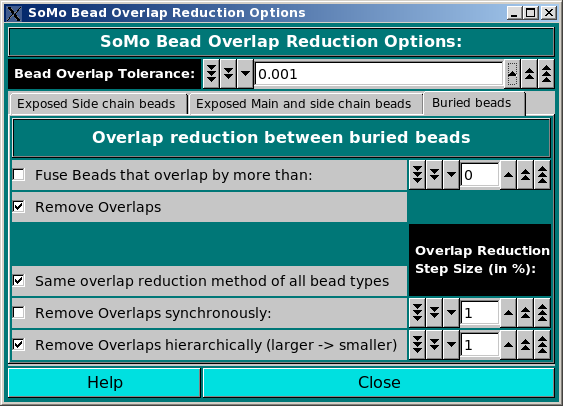
 |
Manual |
In this Module, you set the rules for removing the overlaps between the beads
generated in the first stage of the bead model building process. This operation is
mandatory for a correct computation of the hydrodynamic properties of
the bead model because the hydrodynamic interaction tensor used is valid for
non-overlapping spheres of different radii (Garcia de la Torre and
Bloomfield, Q. Rev. Biophys. 14:81-139, 1981; Spotorno et al., Eur. J. Biophys.
25:373-384, 26:417, 1997).
For SoMo-type bead models, this operation is performed in three stages,
treating first the overlaps between Exposed side chain beads, then the overlaps
between Exposed main and side chain beads, and finally the overlaps between the
Buried beads. The reason behind this procedure is to first adjust the "surface"
of the model, dominated by the exposed side-chains, then complete it with the exposed
main-chain segments, and finally adjust the buried core of the molecule. Although the
last operation can be in principle avoided if the buried beads are excluded from the
hydrodynamic computations, it is safer to perform it because some beads initially classified
as buried might become exposed following overlap removal on the beads initially classified as exposed.
Common to all three Panels, the Bead Overlap Tolerance field sets the
limit (in the model's units) above which the difference between the radii of
two beads will classify them as overlapping (default: 0.001).
Exposed side chain beads:
 |
The first checkbox in this panel, Fuse Beads that overlap by more than:, activates
a "fusion" process between beads that overlap by more than the threshold set in
the corresponding field (default: 70%). This avoids the generation of very
small beads that would result from a simple reduction of their radii. A new bead
is created with a volume equal to the sum of the two original beads, and positioned
in the center of gravity (cog) between the two beads. The fusion process is a hierarchical
procedure in which the couple with the biggest overlap exceeding the threshold is
treated first, and the ensemble is re-screened after each fusion (default:
active).
The second checkbox, Remove Overlaps, dictates if the whole procedure is active. It should be disallowed only for testing purposes or if the model is not used for hydrodynamic computations (default: active). Two alternative methods can then be selected to remove the remaining overlaps not exceeding the fusion threshold: Remove Overlaps synchronously and Remove Overlaps hierarchically (larger -> smaller). An Overlap Reduction Step Size (in %) field controls the finesse in this stage, by setting the step size (in % of the involved radii) used to remove the overlaps (default: 1%). The Same overlap reduction method for all bead types checkbox allow to automatically set the chosen procedure for all bead types (default: active). Furthermore, if this checkbox and the Automatically set suffix checkbox in the main panel are both selected, either the "hi" or "sy" symbol is added to the Bead Model Suffix field in the main panel. |
|
In the Remove Overlaps synchronously procedure, the radii of all beads having an overlap
are reduced by the selected % value in each step, and the ensemble is then
re-screened; beads no longer having an overlap are dropped from the list. If the
Outward Translation checkbox is selected, the beads centers are also moved
outwardly by the same amount along a line connecting them with the cog of the
molecule. The synchronous procedure is time-consuming, especially when
large structures are analyzed. The quality of the models appears to be higher
than that of models generated with the hierarchical procedure (more uniform bead sizes,
less space between beads), but the hydrodynamic parameters are very similar.
In the Remove Overlaps hierarchically (larger -> smaller), the biggest overlap between a couple of beads is first removed by proportionally reducing their radii. If the Outward Translation checkbox is selected, the beads centers are also moved outwardly along a line connecting them with the cog of the molecule. The minimal amount of translation and radius reduction leading to overlap removal is computed by solving a set of equations. If the Outward Translation is active, the couple is removed from the list and whole set is re-screened for overlaps after each overlap is removed, otherwise the couple is just removed from the list and the next one is treated. The Outward Translation was devised to maintain as much as possible the original surface of the molecule, which would otherwise shrink when the overlaps are eliminated by reducing the beads' radii (default: active). |
Exposed main and side chain beads:
 |
Overlaps involving main-main and main-side chain beads are now
treated. As in the previous Panel, the first checkbox in this panel, Fuse Beads
that overlap by more than:, again activates a "fusion" process between beads
that overlap by more than the threshold set in the corresponding field (default: 70%).
A detailed explanation of this procedure can be found in the Exposed side chain beads
panel (default: active). If a fusion events takes places between a main- and a
side-chain bead, the program steps back to the Exposed Side chain beads routine
and re-screens this class for overlaps, removing them if necessary, then it restarts the
second step.
The second checkbox, Remove Overlaps, dictates if the whole procedure is active. It should be disallowed only for testing purposes or if the model is not used for hydrodynamic computations (default: active). Again, two alternative methods can then be selected to remove the remaining overlaps not exceeding the fusion threshold: Remove Overlaps synchronously and Remove Overlaps hierarchically (larger -> smaller). The Overlap Reduction Step Size (in %) field controls the finesse in this stage, by setting the step size (in % of the involved radii) used to remove the overlaps (default: 1%). The Same overlap reduction method for all bead types checkbox allow to automatically set the chosen procedure for all bead types (default: active). |
| No Outward Translation is available in this stage, because the only radii that are reduced are those of the main-chain beads. If an overlap is present between a side-chain bead and a main-chain bead, only the latter has its radius reduced, keeping fixed its center. The two alternative procedures has been fully described in the Exposed Side Chain Beads panel (default: hierarchical). |
Buried beads:
 |
Finally, overlaps between all the beads initially classified as buried are
removed in this stage. As in the previous two Panels, there is a Fuse Beads
that overlap by more than: checkbox, whose use is however NOT recommended. Again,
the second checkbox, Remove Overlaps, dictates if the whole procedure is active.
It should be disallowed only for testing purposes, or if the model is not
used for hydrodynamic computations (default: active).
Only the two alternative options, Remove Overlaps synchronously and Remove Overlaps hierarchically (larger -> smaller) are present in this stage. They are controlled by the Overlap Reduction Step Size (in %) field, and have been fully described in the Exposed side chain beads Panel (default: hierarchical). The Same overlap reduction method for all bead types checkbox allow to automatically set the chosen procedure for all bead types (default: active). |
This document is part of the UltraScan Software Documentation
distribution.
Copyright © notice.
The latest version of this document can always be found at:
http://www.ultrascan.uthscsa.edu
Last modified on September 3, 2009.